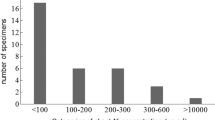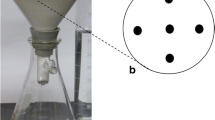Abstract
Selection for metal-tolerant ecotypes of ectomycorrhizal (ECM) fungi has been reported in instances of metal contamination of soils as a result of human activities. However, no study has yet provided evidence that natural metalliferous soils, such as serpentine soils, can drive the evolution of metal tolerance in ECM fungi. We examined in vitro Ni tolerance in isolates of Cenococcum geophilum from serpentine and non-serpentine soils to assess whether isolates from serpentine soils exhibited patterns consistent with adaptation to elevated levels of Ni, a typical feature of serpentine. A second objective was to investigate the relationship between Ni tolerance and specific growth rates (µ) among isolates to increase our understanding of possible tolerance/growth trade-offs. Isolates from both soil types were screened for Ni tolerance by measuring biomass production in liquid media with increasing Ni concentrations, so that the effective concentration of Ni inhibiting fungal growth by 50% (EC50) could be determined. Isolates of C. geophilum from serpentine soils exhibited significantly higher tolerance to Ni than non-serpentine isolates. The mean Ni EC50 value for serpentine isolates (23.4 µg ml−1) was approximately seven times higher than the estimated value for non-serpentine isolates (3.38 µg ml−1). Although there was still a considerable variation in Ni sensitivity among the isolates, none of the serpentine isolates had EC50 values for Ni within the range found for non-serpentine isolates. We found a negative correlation between EC50 and µ values among isolates (r = −0.555). This trend, albeit only marginally significant (P = 0.06), indicates a potential trade-off between tolerance and growth, in agreement with selection against Ni tolerance in “normal” habitats. Overall, these results suggest that Ni tolerance arose among serpentine isolates of C. geophilum as an adaptive response to Ni exposure in serpentine soils.




Similar content being viewed by others
References
Adriaensen K, van der Lelie D, Van Laere A, Vangronsveld J, Colpaert JV (2004) A zinc-adapted fungus protects pines from zinc stress. New Phytol 161:549–555, doi:10.1046/j.1469-8137.2003.00941.x
Adriaensen K, Vralstad T, Noben JP, Vangronsveld J, Colpaert JV (2005) Copper-adapted Suillus luteus, a symbiotic solution for pines colonizing Cu mine spoils. Appl Environ Microbiol 71:7279–7284, doi:10.1128/AEM.71.11.7279-7284.2005
Adriaensen K, Vangronsveld J, Colpaert JV (2006) Zinc-tolerant Suillus bovinus improves growth of Zn-exposed Pinus sylvestris seedlings. Mycorrhiza 16:553–558, doi:10.1007/s00572-006-0072-7
Al-Hiyaly SAK, McNeilly T, Bradshaw AD, Mortimer AM (1993) The effect of zinc contamination from electricity pylons. Genetic constraints on selection for zinc tolerance. Heredity 70:22–32, doi:10.1038/hdy.1993.4
Berglund ABN, Dahlgren S, Westerbergh A (2004) Evidence for parallel evolution and site-specific selection of serpentine tolerance in Cerastium alpinum during the colonization of Scandinavia. New Phytol 161:199–209, doi:10.1046/j.1469-8137.2003.00934.x
Blaudez D, Jacob C, Turnau K, Colpaert JV, Ahonen-Jonnarth U, Finlay R, Botton B, Chalot M (2000) Differential responses of ectomycorrhizal fungi to heavy metals in vitro. Mycol Res 104:1366–1371, doi:10.1017/S0953756200003166
Bradley R, Burt AJ, Read DJ (1982) The biology of mycorrhiza in the Ericaceae. 8. The role of mycorrhizal infection in heavy-metal resistance. New Phytol 91:197–209, doi:10.1111/j.1469-8137.1982.tb03306.x
Bratteler M, Lexer C, Widmer A (2006) Genetic architecture of traits associated with serpentine adaptation of Silene vulgaris. J Evol Biol 19:1149–1156, doi:10.1111/j.1420-9101.2006.01090.x
Brearley FQ (2006) Differences in the growth and ectomycorrhizal community of Dryobalanops lanceolata (Dipterocarpaceae) seedlings grown in ultramafic and non-ultramafic soils. Soil Biol Biochem 38:3407–3410, doi:10.1016/j.soilbio.2006.05.012
Brooks RR (1987) Serpentine and its vegetation, a multidisciplinary approach. Dioscorides, Portland
Brown MT, Wilkins DA (1985) Zinc tolerance of Amanita and Paxillus. Trans Br Mycol Soc 84:367–369
Colpaert JV, Van Assche JA (1987) Heavy metal tolerance in some ectomycorrhizal fungi. Funct Ecol 1:415–421, doi:10.2307/2389799
Colpaert JV, Van Assche JA (1992) The effects of cadmium and the cadmium–zinc interaction on the axenic growth of ectomycorrhizal fungi. Plant Soil 145:237–243, doi:10.1007/BF00010352
Colpaert JV, Vanden Koornhuyse P, Adriaensen K, Van Gronsveld J (2000) Genetic variation and heavy metal tolerance in the ectomycorrhizal basidiomycete Suillus luteus. New Phytol 147:367–379, doi:10.1046/j.1469-8137.2000.00694.x
Colpaert JV, Muller LAH, Lambaerts M, Adriaensen K, Vangronsveld J (2004) Evolutionary adaptation to Zn toxicity in populations of Suilloid fungi. New Phytol 162:549–559, doi:10.1111/j.1469-8137.2004.01037.x
Dahlgren RA, Singer MJ, Huang X (1997) Oak tree and grazing impacts on soil properties and nutrients in a California oak woodland. Biogeochemistry 39:45–64, doi:10.1023/A:1005812621312
Deacon JW (2006) Fungal biology, 4th edn. Blackwell, Malden
Denny HJ, Wilkins DA (1987) Zinc tolerance in Betula spp. 3. Variation in response to zinc among ectomycorrhizal associates. New Phytol 106:535–544
di Pietro M, Churin JL, Garbaye J (2007) Differential ability of ectomycorrhizas to survive drying. Mycorrhiza 17:547–550, doi:10.1007/s00572-007-0113-x
Douhan GW, Rizzo DM (2005) Phylogenetic divergence in a local population of the ectomycorrhizal fungus Cenococcum geophilum. New Phytol 166:263–271, doi:10.1111/j.1469-8137.2004.01305.x
Douhan GW, Huryn KL, Douhan LI (2007) Significant diversity and potential problems associated with inferring population structure within the Cenococcum geophilum species complex. Mycologia 99:812–819, doi:10.3852/mycologia.99.6.812
Egerton-Warburton LM, Griffin BJ (1995) Differential responses of Pisolithus tinctorius isolates to aluminum in vitro. Can J Bot 73:1229–1233, doi:10.1139/b95-133
Fomina MA, Alexander IJ, Colpaert JV, Gadd GM (2005) Solubilization of toxic metal minerals and metal tolerance of mycorrhizal fungi. Soil Biol Biochem 37:851–866, doi:10.1016/j.soilbio.2004.10.013
Fries N (1978) Basidiospore germination in some mycorrhiza-forming Hymenomycetes. Trans Br Mycol Soc 70:319–317
Godbold DL, Jentschke G, Winter S, Marschner P (1998) Ectomycorrhizas and amelioration of metal stress in forest trees. Chemosphere 36:757–762, doi:10.1016/S0045-6535(97)10120-5
Gonçalves SC, Gonçalves MT, Freitas H, Martins-Loucão MA (1997) Mycorrhizae in a Portuguese serpentine community. In: Jaffré T, Reeves RD, Becquer T (eds) The ecology of ultramafic and metalliferous areas. Proceedings of the 2nd International Conference on Serpentine Ecology, Nouméa, pp 87–89
Gonçalves SC, Portugal A, Goncalves MT, Vieira R, Martins-Loucao MA, Freitas H (2007) Genetic diversity and differential in vitro responses to Ni in Cenococcum geophilum isolates from serpentine soils in Portugal. Mycorrhiza 17:677–686, doi:10.1007/s00572-007-0145-2
Griffin DH (1994) Fungal physiology, 2nd edn. Wiley, New York
Hartley E, Cairney JWG, Sanders FE, Meharg AA (1997a) Toxic interactions of metal ions (Cd2+, Pb2+, Zn2+and Sb3−) on in vitro biomass production of ectomycorrhizal fungi. New Phytol 137:551–562, doi:10.1046/j.1469-8137.1997.00835.x
Hartley J, Cairney JWG, Meharg AA (1997b) Do ectomycorrhizal fungi exhibit adaptive tolerance to potentially toxic metals in the environment. Plant Soil 189:303–319, doi:10.1023/A:1004255006170
Hughes R, Bachmann K, Smirnoff N, Macnair MR (2001) The role of drought tolerance in serpentine tolerance in the Mimulus guttatus Fischer ex DC. complex. S Afr J Sci 97:581–586
Jany JL, Garbaye J, Martin F (2002) Cenococcum geophilum populations show a high degree of genetic diversity in beech forests. New Phytol 154:651–659, doi:10.1046/j.1469-8137.2002.00408.x
Jentschke G, Goldbold DL (2000) Metal toxicity and ectomycorrhizas. Physiol Plant 109:107–116, doi:10.1034/j.1399-3054.2000.100201.x
Jones MD, Hutchinson TC (1988) The effects of nickel and copper on the axenic growth of ectomycorrhizal fungi. Can J Bot 66:119–124
Levins R (1968) Evolution in changing environments. Princeton University Press, Princeton
LoBuglio KF, Taylor JW (2002) Recombination and genetic differentiation in the mycorrhizal fungus Cenococcum geophilum Fr. Mycologia 94:772–780, doi:10.2307/3761692
Maas JL, Stuntz DE (1969) Mycoecology on serpentine soil. Mycologia 61:1106–1116, doi:10.2307/3757496
McCreight JD, Schroeder DB (1982) Inhibition of growth of nine ectomycorrhizal fungi by cadmium, lead, and nickel in vitro. Environ Exp Bot 22:1–7, doi:10.1016/0098-8472(82)90002-8
Mengoni A, Barabesi C, Gonnelli C, Galardi F, Gabbrielli R, Bazzicalupo M (2001) Genetic diversity of heavy metal-tolerant populations in Silene paradoxa L. (Caryophyllaceae): a chloroplast microsatellite analysis. Mol Ecol 10:1909–1916, doi:10.1046/j.0962-1083.2001.01336.x
Mexal J, Reid CPP (1973) Growth of selected mycorrhizal fungi in response to induced water stress. Can J Bot 51:1579–1588, doi:10.1139/b73-201
Miller SP, Cumming JR (2000) Effects of serpentine factors on Virginia pine (Pinus virginiana) seedlings. Tree Physiol 20:1129–1135
Moser AM, Petersen CA, D'Allura JA, Southworth D (2005) Comparison of ectomycorrhizas of Quercus garryana (Fagaceae) on serpentine and non-serpentine soils in southwestern Oregon. Am J Bot 92:224–230, doi:10.3732/ajb.92.2.224
Muller LAH, Lambaerts M, Vangronsveld J, Colpaert JV (2004) AFLP-based assessment of the effects of environmental heavy metal pollution on the genetic structure of pioneer populations of Suillus luteus. New Phytol 164:297–303, doi:10.1111/j.1469-8137.2004.01190.x
Muller LAH, Vangronsveld J, Colpaert JV (2007) Genetic structure of Suillus luteus populations in heavy metal polluted and nonpolluted habitats. Mol Ecol 16:4728–4737, doi:10.1111/j.1365-294X.2007.03549.x
Nabais C (2000) Seasonal transport, allocation and speciation of nickel in Quercus ilex grown in serpentine and nickel spiked soil. PhD thesis. University of Coimbra
Panaccione DG, Sheets NL, Miller SP, Cumming JR (2001) Diversity of Cenococcum geophilum isolates from serpentine and non-serpentine soils. Mycologia 93:645–652, doi:10.2307/3761819
Portugal A, Martinho P, Vieira R, Freitas H (2001) Molecular characterization of Cenococcum geophilum isolates from an ultramafic soil in Portugal. S Afr J Sci 97:617–619
Portugal A, Gonçalves SC, Vieira R, Freitas H (2004) Characterization of Cenococcum geophilum isolates from a serpentine area by microsatellite-primed PCR. A tool for future revegetation programmes. In Boyd RS, Baker AJM, Proctor J (eds) Ultramafic rocks: their soils, vegetation and fauna. Proceedings of the 4th International Conference on Serpentine Ecology, Havana, pp 215–221
Proctor J, Woodell SRJ (1975) The ecology of serpentine soils. Adv Ecol Res 9:256–347
Rajakaruna N, Baldwin BG, Chan R, Desrochers AM, Bohm BA, Whitton J (2003) Edaphic races and phylogenetic taxa in the Lasthenia californica complex (Asteraceae: Heliantheae): an hypothesis of parallel evolution. Mol Ecol 12:1675–1679, doi:10.1046/j.1365-294X.2003.01843.x
Sharples JM, Meharg AA, Chambers SM, Cairney JWG (2001) Arsenate resistance in the ericoid mycorrhizal fungus Hymenoscyphus ericae. New Phytol 151:265–270, doi:10.1046/j.1469-8137.2001.00146.x
SPSS (2002) SigmaPlot for Windows, Release 8.02, Chicago, IL, USA
SPSS (2003) SigmaStat for Windows, Release 3.0.1, Chicago, IL, USA
Tam PCF (1995) Heavy-metal tolerance by ectomycorrhizal fungi and metal amelioration by Pisolithus tinctorius. Mycorrhiza 5:181–187, doi:10.1007/BF00203335
Taylor DL (2000) A new dawn—the ecological genetics of mycorrhizal fungi. New Phytol 147:236–239, doi:10.1046/j.1469-8137.2000.00709.x
Thompson GW, Medve RJ (1984) Effects of aluminum and manganese on the growth of ectomycorrhizal fungi. Appl Environ Microbiol 48:556–560
Urban A, Puschenreiter M, Strauss J, Gorfer M (2008) Diversity and structure of ectomycorrhizal and co-associated fungal communities in a serpentine soil. Mycorrhiza 18:339–354, doi:10.1007/s00572-008-0189-y
Wilkins DA (1991) The influence of sheathing (ecto-) mycorrhizas of trees on the uptake and toxicity of metals. Agric Ecosyst Environ 35:245–260, doi:10.1016/0167-8809(91)90053-Z
Wilkinson DM, Dickinson NM (1995) Metal resistance in trees: the role of mycorrhizae. Oikos 72:298–300, doi:10.2307/3546233
Wright JW (2007) Local adaptation to serpentine soils in Pinus ponderosa. Plant Soil 293:209–217, doi:10.1007/s11104-006-9181-5
Acknowledgments
This study was part of S.C. Gonçalves PhD project funded by FCT (PRAXIS XXI/BD/16257/98). We are grateful to Greg Douhan and Dan Panaccione for providing us the isolates of C. geophilum from California and Maryland, USA, respectively. Thanks are due to S.R. Costa, M.T. Gonçalves, C. Moura, and A. Portugal for their critical reading of the manuscript.
Author information
Authors and Affiliations
Corresponding author
Electronic Supplementary Material
Below is the link to the electronic supplementary material.
ESM 1
(DOC 2.20 MB)
Rights and permissions
About this article
Cite this article
Gonçalves, S.C., Martins-Loução, M.A. & Freitas, H. Evidence of adaptive tolerance to nickel in isolates of Cenococcum geophilum from serpentine soils. Mycorrhiza 19, 221–230 (2009). https://doi.org/10.1007/s00572-008-0211-4
Received:
Accepted:
Published:
Issue Date:
DOI: https://doi.org/10.1007/s00572-008-0211-4




